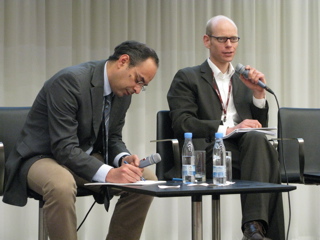Hard numbers: A crowded house, a distant target
Dec 16, 2009 - by Staff
Dec 16, 2009 - by Staff
Bob Henson | 16 December 2009 • Sometimes the numbers just don’t add up, even when you know they need to. Attendees at the Copenhagen meeting got a taste of that on Monday and Tuesday, 14–15 December, as the massive meeting struggled to accommodate its guests. Many waited in a near-freezing outdoor line for seven or more hours to register, only to find the Bella Center filled to capacity before they could get in. More multiple-hour waits occurred on Tuesday to mounting frustration.
UNFCCC media coordinator Alex Wuestenhagen gave some perspective to reporters by going through the counts of expected attendees as of Monday:
By midday Monday, the conference had issued 22,387 badges, but the conference center only holds 15,000 people—thus the gridlock. In order to accommodate the heads of state and their delegations arriving on Wednesday and thereafter, the UNFCC is resorting to drastic measures. Only about one-third of the NGO representatives are being allowed on Wednesday, with the number dropping to 1,000 on Thursday and only 90 on Friday. Combined with the long queues early in the week, that could keep many people who traveled to Copenhagen for the week from ever making it into the meeting.
In much the same way, the emission numbers being tossed around in negotiations as of Tuesday afternoon weren’t adding up yet to an end-of-week agreement. As with previous UNFCCC meetings, a marathon last day of negotiations could be in the cards.
 Keywan Riahi (International Institute for Applied Systems Analysis) and Niklas Höhne (Ecofys) appeared on the panel.
Keywan Riahi (International Institute for Applied Systems Analysis) and Niklas Höhne (Ecofys) appeared on the panel.
Meanwhile, some of those shut out from the Bella Center will gravitate to hundreds of “side events” taking place at hotels and other venues across Copenhagen. Typically sponsored by NGOs, these events give stakeholders—from hard-core activists to green capitalists—a chance to air their views and talk among themselves.
Targets and timeframes: NCAR sponsored a research-oriented side event on Tuesday night that brought together three panelists and several dozen participants in a lively discussion of emissions targets. Opening the event was Keywan Riahi (International Institute for Applied Systems Analysis), a coauthor with NCAR’s Brian O’Neill and Ilkka Keppo (Energy Research Center of the Netherlands) on a soon-to-be-published paper in Proceedings of the National Academy of Sciences. The paper is the first to examine how conditions in 2050 will relate to longer-term targets based on an integrated assessment involving climatic, energy, and societal variables.
One of the trickiest aspects of setting targets is overshoot: how much emissions might exceed the path toward a long-term goal before hitting that goal in the end. Riahi stressed the dangers of overshooting, including the risk that one or more climatic tipping points might be triggered along the way.
Anand Patwardhan (Indian Institute of Technology) noted the complexity of considering what society will do sooner rather than later. “We actually need to link three time scales [near, medium, and long-term], and it’s not obvious how we should do that,” Patwardhan said.
 Nebojsa Nakicenovic, deputy director of the International Institute for Applied Systems Analysis, poses a question to the panel.
Nebojsa Nakicenovic, deputy director of the International Institute for Applied Systems Analysis, poses a question to the panel.
Niklas Höhne brought the discussion to a near-term frame as he presented a breakdown of how two kinds of pledges on the Copenhagen table—“low ambition” (what countries will do no matter what) and “high ambition” (what countries will do with assistance)—will affect emissions in 2020. Even with both kinds of pledges taken into account, emissions would drop less than 10% from a business-as-usual track, said Höhne. “We are not there yet,” he said.
Höhne’s company is offering a quick way to keep track of the week’s progress in Copenhagen. Its Climate Action Tracker shows where current proposals would send the planet’s average temperature by 2100 (as of Monday, the value was 3.5°C or 6.3°F, compared to a widely accepted goal of 2.0°C or 3.6°F). Users can click on a world map to view the commitments offered by each country, along with a rating from “inadequate” (China, European Union, United States, and several other large countries) to “role model” (Costa Rica and the Maldives, both of which aim to become carbon neutral by the 2020s.
Another place to watch the saga unfold is the Climate Scoreboard, offered by the Sustainability Institute. Its take is more pessimistic still: on both Monday and Tuesday, the scoreboard showed a 2100 temperature increase of 3.9°C (7.0°F).
 California governor Arnold Schwarzenegger.
California governor Arnold Schwarzenegger.
Celebrity watch: Luminaries of politics and cinema (and in at least one case, of both) are descending upon Copenhagen in force. Among those making appearances or giving talks on Tuesday were Bianca Jagger, Daryl Hannah, Al Gore, and Prince Charles. California governor Arnold Schwarzenegger met with reporters briefly, advancing his view that regions, cities, private enterprise, and individuals can bypass global roadblocks on climate-change mitigation and accomplish much on their own. “We’ve proved that over and over again in California,” he said.